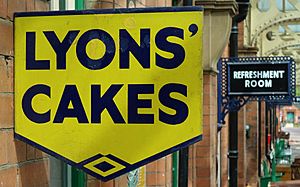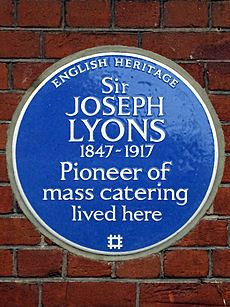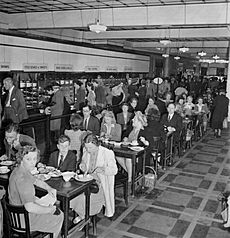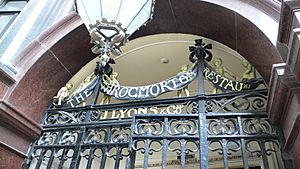J. Lyons and Co. facts for kids
J. Lyons & Co. was a famous British company that started in 1884. It was known for its restaurants, making food, and owning hotels. The company was founded by Joseph Lyons and his brothers-in-law, Isidore and Montague Gluckstein.
Lyons opened its first teashop in Piccadilly, London, in 1894. By 1909, it had grown into a chain of teashops, becoming a common sight on the main streets of the UK. At its busiest, the company had about 200 cafes. These teashops served tea and coffee, along with hot and cold meals, sweets, buns, cakes, and rolls.
Lyons started making cakes and pastries in 1894. Even today, you can find some Lyons cake products in stores, like Lyons treacle tart, Lyons Bakewell tart, Lyons Battenberg, and Lyons trifle sponges. These are now sold by another company called Premier Foods. J. Lyons & Co. was also famous for being one of the first companies to use computers in their offices.
Contents
How J. Lyons & Co. Started
The company began when Joseph Lyons, an artist, teamed up with his brothers-in-law, Isidore and Montague Gluckstein. They started the company as a new business idea from their family's tobacco company, Salmon & Gluckstein.
In 1894, J. Lyons & Co. opened its first teashop in Piccadilly, London. From 1909, this grew into a chain of teashops that eventually had around 200 locations. The company also owned fancy restaurants, like the Trocadero which opened in 1895. They also had hotels in London, such as the Strand Palace (1909), the Regent Palace (1915), and the Cumberland Hotel (1933).
In 1918, Lyons bought Horniman & Sons, an old tea company, to sell more products in northern England. From the 1930s, Lyons started making new types of teas, biscuits, and cakes. These were sold in grocery stores all over the world. The company was named after Joseph Lyons, who was chosen to run it.
J. Lyons & Co. was a leader in using computers for business. Between 1951 and 1963, the company even made and sold its own LEO (Lyons Electronic Office) computers.
What J. Lyons & Co. Made and How It Looked

J. Lyons & Co. was a big food maker. They had factories in Cadby Hall in Hammersmith and, from 1921, in Greenford. These factories made bread, cakes, pies, tea, coffee, and ice cream. Some of their famous cakes included treacle tarts, Lyons Bakewell tart, Lyons Battenberg, and Lyons trifle sponges.
Most people knew J. Lyons & Co. for their chain of teashops. These shops opened in 1894 and closed in 1981. They were also famous for the Lyons Corner Houses in the West End of London. The teashops offered tea and coffee, along with hot and cold dishes, sweets, buns, cakes, and rolls.
Lyons’ teashops were a bit fancier than their competitors, like the ABC (Aerated Bread Company). They were known for their beautiful interior design. From the 1920s, Oliver P. Bernard was their artistic director. Before the 1940s, they were quite stylish for working-class people. By the 1950s and 1960s, they became quick stops for busy shoppers to grab a cup of tea, a snack, or a cheap meal.
The teashops always had a bakery counter at the front. Their signs, with gold letters on white in an art nouveau style, were easy to spot. Before World War II, uniformed waitresses called 'Nippies' served customers at their tables. After the war, the teashops changed to a cafeteria style, where customers served themselves.
Lyons Corner Houses
Lyons' Corner Houses first opened in 1909 and stayed open until 1977. They were famous for their art deco style. These large buildings had four or five floors and were located on or near the corners of Coventry Street, Strand, and Tottenham Court Road. There were also Maison Lyonses at Marble Arch and in Shaftesbury Avenue.
The ground floor of a Corner House was a food hall. It had counters for special foods, sweets, chocolates, cakes, fruit, and flowers. They also had hair salons, phone booths, and places to book theatre tickets. At one point, they even offered a food delivery service twice a day. On the other floors, there were several restaurants, each with a different theme and its own musicians. For a while, the Corner Houses were open 24 hours a day. At their busiest, each branch had about 400 staff members. They featured amazing window displays. After the war, the Corner Houses were smarter and grander than the local teashops.
Other Restaurants and Hotels
Besides the teashops and Corner Houses, Lyons also ran other large restaurants. These included the Angel Cafe Restaurant in Islington and the Throgmorton in Throgmorton Street in the City of London. Over the years, Lyons also owned or operated other popular food chains. These included Steak Houses (from 1961 to 1988), Wimpy Bars (from 1953 to 1976), Baskin-Robbins (from 1974 to today), and Dunkin' Donuts (from 1989 to today).
Lyons also owned several hotels through its subsidiary, Strand Hotels Limited. The Regent Palace Hotel in London opened on May 16, 1915. Other hotels included the Cumberland Hotel, Kingsley Hotel, Park Court Hotel, Windsor Hotel, White's Hotel, and the Strand Palace Hotel. The last London hotel they ran was the Tower Hotel, located near Tower Bridge.
Biscuits Company
In 1938, Lyons bought the Bee Bee Biscuit Company, which made biscuits in Blackpool. Six years later, Lyons changed the company's name to Symbol Biscuits Ltd. They started selling biscuits under the Symbol and Lyons brand names. One of their new ideas was Maryland Cookies in 1956. In 1990, Lyons changed the Symbol Biscuits name to Lyons Biscuits Ltd.
Other Important Activities
Helping During Wartime
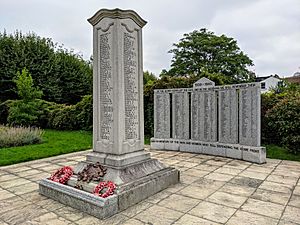
Before World War II, Britain was preparing for war. Many Royal Ordnance Factories (ROFs), which were government-owned factories, were built. Because there weren't enough people to manage them, some ROFs were run by private companies. J. Lyons & Co. ran at least one of these, ROF Elstow. The company's experience in managing food supplies and perishable goods was very helpful for controlling raw materials and finished products in these factories. Lyons stopped managing these factories after 1945.
Princess Elizabeth's Wedding Cake
Princess Elizabeth (who later became Queen Elizabeth II) and Philip Mountbatten received many cakes from people around the world for their wedding on November 20, 1947. They only accepted 12 of these, and one was from J. Lyons & Co.
Lyons created a beautiful three-tiered cake, placed on a silver stand. It was made by F E Jacobs, the chief decorator for Lyons’ Ornamental Department. The cake was 1.8 meters (about 6 feet) tall and weighed 63 kg (about 139 pounds). The first and second layers had special 10 cm blue and white Wedgewood Jasper vases set in small spaces behind silver pillars. Smaller vases were on the third layer. The cake also showed Princess Elizabeth’s coat of arms, the couple’s initials, and a Naval crown. On top of the third layer was a larger Jasper vase filled with fresh flowers and trailing orange blossoms.
Pioneering Computers in Business
The leaders at Lyons, who already used mechanical adding machines, understood that new electronic computers were needed. They wanted to better organize the delivery of cakes and other foods that spoiled quickly. So, they helped pay for the University of Cambridge's Electronic Delay Storage Automatic Calculator (EDSAC), which was one of the first electronic digital computers used regularly.
Lyons then built their own programmable digital computers. They became the first business to use these computers with the LEO I digital computer, which stood for Lyons Electronic Office I. This computer was designed and built by Dr. John Pinkerton, led by John Simmons. It managed the company's accounts and logistics (how things were moved and stored). Lyons even used weather forecasts to make sure their "fresh produce" delivery vans didn't waste large amounts of food. Google chairman Eric Schmidt called this "the world's first office computer," built in 1951. A separate company, LEO Computers Ltd, was formed in 1954. It went on to build 11 Leo II and 94 Leo III computers that were sold worldwide.
One of the main users of LEO computers was the General Post Office (GPO). They bought them in the mid-1960s to create telephone bills. These computers were used until 1981, partly by using parts from other companies' old machines.
The Decline of J. Lyons & Co.
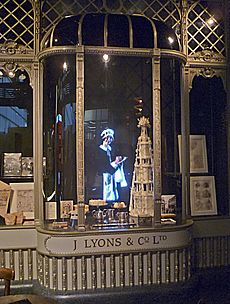
J. Lyons & Co. started losing money in the 1960s. The company was still controlled by the Salmon family, who were descendants of a founding partner. Lyons began to close some of its London teashops and hotels. In 1963, they also combined their LEO Computers business with English Electric's computer interests to form a new company called English Electric LEO.
In 1964, Lyons sold its share in the computer business. English Electric then combined it with Marconi's computer interests to form English Electric LEO Marconi Computers. A big challenge for British computer companies was a lack of money to invest and strong competition from much larger U.S. companies like IBM. English Electric LEO Marconi Computers later merged with other companies to form International Computers Limited (ICL), which was bought by Fujitsu in 1990.
In 1978, Lyons was bought by Allied Breweries and became part of a larger group called Allied Lyons. The company faced tough economic times in the late 1980s and was eventually sold off in pieces. Its ice cream and ice lolly products, known as Lyons Maid, were sold to Nestlé. Other parts that were sold included Lyons Cakes (which ended up with Premier Foods) and Ready Brek cereal (which ended up with Weetabix Limited). At the end of 1994, Lyons sold Lyons Biscuits to Hillsdown Holdings, which later sold it to a U.S. investment firm. This firm then sold it to the British biscuit maker Burton's Foods. Today, Lyons’ cake products, like Bakewell tart and Battenberg, are owned by Premier Foods.
The old records of J. Lyons & Co. are now kept in the London Metropolitan Archives.
Famous People Who Worked at Lyons
Former British Prime Minister Margaret Thatcher worked as a chemist for the company before she became a lawyer and then a Conservative Party MP. While working at Lyons, she helped create ways to keep ice cream from melting too quickly.
Peter Bird started by operating the LEO computer and eventually became a director of Lyons Computer Services. He later wrote a book about the company and its computers.
|



